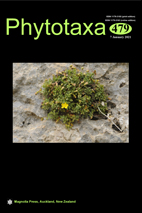Abstract
Three new needle-shaped Fragilaria species from freshwater lake Apastepeque in El Salvador (Fragilaria salvadoriana sp. nov., F. maarensis sp. nov.) and subsaline lake Nam Co on the Tibetan Plateau (F. huebeneri sp. nov.) are described and compared based on light and scanning electron microscopy observations and morphometric analyses. Fragilaria salvadoriana sp. nov. is characterized by narrowly linear-lanceolate, sometimes centrally constricted valves, subcapitate to rarely capitate apices, and a distinct, dented appearing central area. Striae are composed of 2−5 occluded areolae. It can be differentiated from similar needle-shaped species by the valve outline, relatively low striae density, and shark fin-shaped spines. Characteristic of F. maarensis sp. nov. are a very narrowly lanceolate valve outline and subcapitate apices. The apical pore field is composed of 2–3 rows of poroids and acute, irregularly oriented spines are present at the junction between valve face and mantle. This taxon is clearly different from other Fragilaria species, displaying a high length-to-width ratio and a low number of areolae per stria. The Tibetan species, F. huebeneri sp. nov., forms long ribbon-like colonies linked together by spatula-shaped spines. Valves have subcapitate apices, a spindle- to needle-shaped outline and an indistinct central area. Striae are alternate and composed of 3–5 areolae per stria. Teratological forms of F. huebeneri sp. nov. were commonly observed in the sediment trap samples. Fragilaria salvadoriana sp. nov. and F. maarensis sp. nov. were found in a warm, tropical crater lake characterized by low conductivity and dissolved oxygen content, medium alkaline pH, and magnesium-calcium-bicarbonate-rich waters. Fragilaria huebeneri sp. nov. was frequent in a large, high elevation lake with increased specific conductivity, alkaline pH and sodium-bicarbonate-rich waters. The new species are compared to morphologically similar species from the genus Fragilaria Lyngbye and ecological preferences are discussed.

